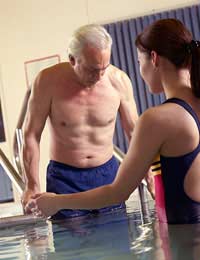Swimming for Back Pain

Swimming is highly recommended as an effective way of keeping muscles and joints supple and strong.
It is a non-impact activity meaning that the weightless environment of the water coupled with the suspension in water takes the pressure off joint allowing them and the associated structures to relax. When these structures become relaxed any compression on the nerves is reduced.
Swimming helps prevent and heal muscular sprains and strains and can help lower chronic pain conditions. It does not exert high amounts of pressure on the back.
It is recommended in the recovery of lower back pain and is a good resistance training exercise for increasing strength and tone. The nature of swimming helps to increase blood circulation, thereby increasing the nutrients and oxygen supply to areas of damage, aiding in the healing process.
In the event of a recent back injury, there are certain precautions that can be taken to avoid exacerbating the pain and damage to the spine and its structures.
Precautions
If your GP has confirmed a spinal condition with a definite diagnosis, always check before participating in this activity.Strokes that require excessive head movement can increase the risk of further damage, especially to injuries of the cervical spine, correct technique must be ascertained to avoid any complications.Back stroke can cause fatigue of the neck and shoulder region resulting in any existing injury to take longer to heal.When performing the front crawl, the swimmer may experience excessive extension of the lower back, again worsening the condition.
If pain levels increase whilst swimming, stop and seek advice from a healthcare professional or swimming instructor as stroke technique may need perfecting.
Preventative Measures
- Always ensure strokes are being executed properly; movements should not be ‘jerky’ or cause panic or struggle with the swimmer.
- Keep the body level and well supported by pulling the abdominal muscles in and up.
- When taking breaths, especially with the front crawl, try not to twist your head to the side, and instead roll the whole body.If necessary, use a breathing aid such as a snorkel to reduce to chance of twisting the neck or shoulders.
- Use a flotation device to help keep the body straight and allow for non-twisting head movements when breathing.
- Choose your own pace and don’t let others influence you.
- If necessary hold onto the side for a few sessions until confidence and strength has been built up. This allows for the legs to take up the strain whilst the upper body is held in a straight and supported stance.
- Try and go with a friend, who can assist as both an aid, in case of further damage, and as someone who can help perfect your technique.
- It is best to alternate your strokes to avoid excessive muscle strain, with the most beneficial being swimming on your side, changing sides regularly.
Remember: if there is an existing condition, it is best to seek medical advice before embarking on any training programme.
Business Energy With a Difference
If you are looking for business energy or need advanced solutions like remote energy monitoring, new supplies, downgrading or upgrading capacity, have a no obligation chat with Purely Energy.
To find our more get in touch here. or call 0161 521 3400.








